
The Solar-Terrestrial Centre of Excellence (STCE) is a collaborative network of the Belgian Institute for Space Aeronomy, the Royal Observatory of Belgium and the Royal Meteorological Institute of Belgium.
 |
Published by the STCE - this issue : 29 Aug 2014. The Solar-Terrestrial Centre of Excellence (STCE) is a collaborative network of the Belgian Institute for Space Aeronomy, the Royal Observatory of Belgium and the Royal Meteorological Institute of Belgium. |
| Archive of the newsletters | Subscribe to this newsletter by mail |
Last week, the Sun produced a few M-class (medium) flares. However, the strongest flare -an M5.9 peaking at 12:17UT on 24 August- originated from NOAA 2151, a relatively small and magnetically simple sunspot group near the southeast solar limb. It was the strongest flare since the M6.5 flare on 8 July and the X-class flares on 10-11 June. Images underneath show the affected area on the Sun in white light and gradually overlaid by extreme ultraviolet imagery (SDO/AIA 304). This indicates that the position of the flare and the erupted material was actually a bit behind the sunspot group.
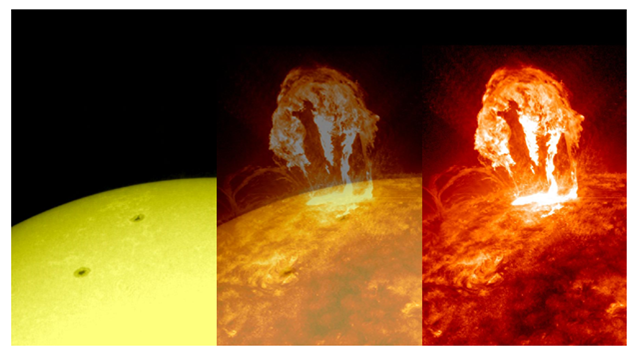
This movie at http://youtu.be/AfCofLMTnOg shows the eruption in successively higher temperatures in the solar atmosphere (AIA 304, 171 and 131). The combination movie shows that the flare is actually related to the eruption of a small, dense filament, which might have become unstable from previous nearby solar activity. A series of post-flare coronal loops ("arcade") can be seen, but there's no obvious sign of coronal dimming or an EIT wave (PROBA2/SWAP difference images; see also http://stce.be/news/241/welcome.html). A type II burst was recorded by the Humain Solar radio Observatory, indicating that a shock travelled through the solar atmosphere with a speed of 593km/s as estimated by the San Vito station. The coronal mass ejection (CME) was seen propagating mostly in the eastern direction, with a plane-of-the-sky speed of 473km/s (CACTus estimate).
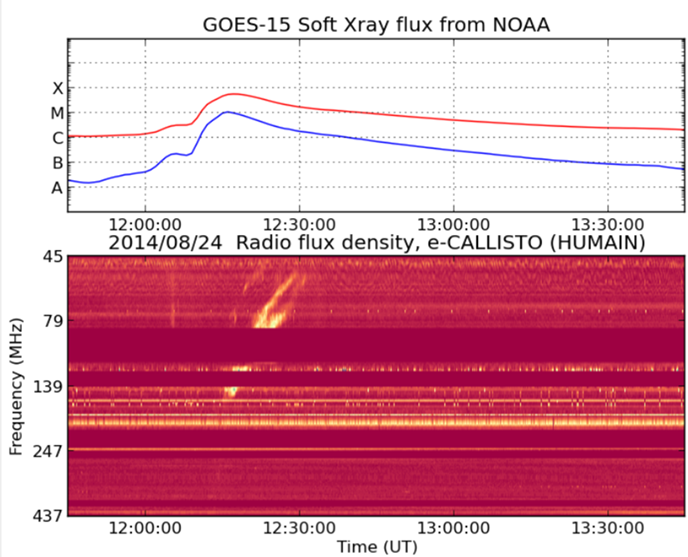
The interesting thing about this CME is that SOHO/Lasco imagery indicates that part of the erupted core filament is not ejected, but reaches a height of about 4 solar radii before raining back along the magnetic field lines onto the solar surface. This is not so uncommon, with the 7 June 2011 eruption a notorious example (see this news item at http://stce.be/news/137/welcome.html).

Credits - Data and imagery were taken from SDO/AIA (http://sdo.gsfc.nasa.gov/data/aiahmi/), PROBA2/SWAP (http://proba2.oma.be/ssa), SOHO/LASCO http://sohowww.nascom.nasa.gov/), Humain Solar Radio Observatory (http://www.sidc.be/humain/), Cactus (www.sidc.oma.be/cactus/), Solar Demon (http://solardemon.oma.be/flares.php), (J)Helioviewer (http://helioviewer.org/#), and daily reports from NOAA/SWPC (http://www.swpc.noaa.gov/Data/index.html) and SIDC/RWC (http://www.sidc.be/).
From 18 till 21 August, the seventh Solar Information Processing Workshop (SIP7) took place in the lovely town of La Roche-en-Ardenne, Belgium. About 80 solar and space scientists, statisticians, and data processing experts from all over the world convened to discuss the challenges of optimizing the science return of solar and heliospheric missions and to address the data analysis issues of these missions. They gathered in the Floreal, a quiet holiday resort on the banks of the Ourthe river, which welcomed them with an extensive reception on Sunday evening.

Five sessions were distributed over 4 days. Topics included power laws in solar physics, the prediction of solar flares and disturbances, the tracking of small scale magnetic features, the variability of the solar wind, and the optimal combination of in-situ and imaging data. Most sessions were introduced with a tutorial, providing the necessary background and context for further discussions. These introductions were then followed by invited and contributing talks highlighting the latest results and advances. Often, these talks resulted in extensive and high-level Q-and-A sessions.
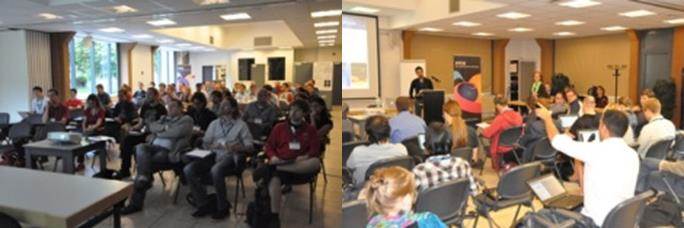
In order to avoid overheating of the participants' brains, timely coffee breaks provided the necessary relieve and possibility to get more acquainted with each other and each other's work on an informal base. During these breaks as well as over the lunch pause, participants had also the opportunity to play a game of Kubb. This is a game with wooden blocks that seemed even more complex than some of the statistics and algorithms that were presented during the sessions!


The afternoons usually started with a few more talks. These were followed by poster sessions and working group (WG) splinter sessions. The three working groups focused on specific problems related to the tracking of magnetic features, the prediction of solar disturbances, and the optimal combination of in-situ/remote sensing data. The WGs aimed at encouraging informal discussions by all participants to spark collaborations and how to improve the accuracy of predictions and tracking. The WGs convened in specific break-out rooms on Monday and Wednesday, and the results were presented at the end of the workshop.

On Monday, there was also a 2-hour demo session, during which as many as six software applications were presented in parallel. Hence, the participants had ample opportunity to learn more on JHelioviewer, SoFAST, SunPy, SWAMIS,... just to name a few. On Tuesday, micro-workshops addressed five specific problems related to SIP. The aim was to exchange ideas how to tackle issues such as the study of Quasi-Periodic Pulsations in solar flares, the detection of Coronal Mass Ejections, to-do's for SunPy,... The identified problems and potential solutions echoed through into the animated panel discussion that ended the SIP7 workshop.
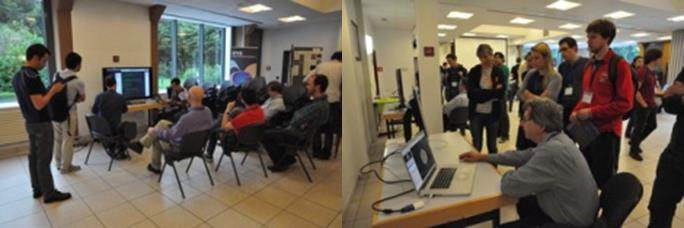
From the program above, it may be clear that these were long and intense days. Fortunately, social activities came to the rescue. There was a beer-tasting event on Monday evening, and a conference dinner on Wednesday evening near Bastogne (including a visit to the Mardasson "Battle of the Bulge" Memorial). On Thursday afternoon, there was a nice hike in the surrounding woods, and the conference ended with a barbecue, after which some of the participants went out to catch a glimpse of the dreaded ghost of the castle (whooo!...).

The program of SIP7, links to the various presentations, and pictures of the meeting and social activities can be found at the website of SIP7 (http://www.stce.be/sipworkshop2014/). Papers related to this workshop will be gathered in a special issue of the SWSC Journal (http://www.swsc-journal.org/). The next SIP workshop ("SIP8") will take place in Boulder in 2016.

The level of solar activity was very low to moderate this week. Three M-flares were recorded, all originating from emerging active regions on the East limb (i.e. AR 12149 and AR 12151).
In order to view the activity of this week in more detail, we suggest going to the following website from which all the daily (normal and difference) movies can be accessed: http://proba2.oma.be/ssa.
This page also lists the recorded flaring events.
A weekly overview movie can be found here: http://proba2.oma.be/swap/data/mpg/movies/WeeklyReportMovies/WR230_Aug18_Aug_24/weekly_movie_2014_08_18.mp4 (SWAP week 230).
Details about some of this week’s events, can be found further below.
On Tuesday 19th, a prominence eruption occurred on the North limb. It can (barely) be seen on the weekly overview movie (see above). It is a long duration occurrence, which triggers, on Thursday Aug 21st, the eruption of another prominence, better visible, slightly to the NNW, as well as the disturbance of the high coronal feature situated above the NNE limb.
A long series of 11 EIT waves can be seen being generated over at least 5 days, all originating from the Western tip of AR 12146. All the EIT waves are directed westward. A few of them are shown below.
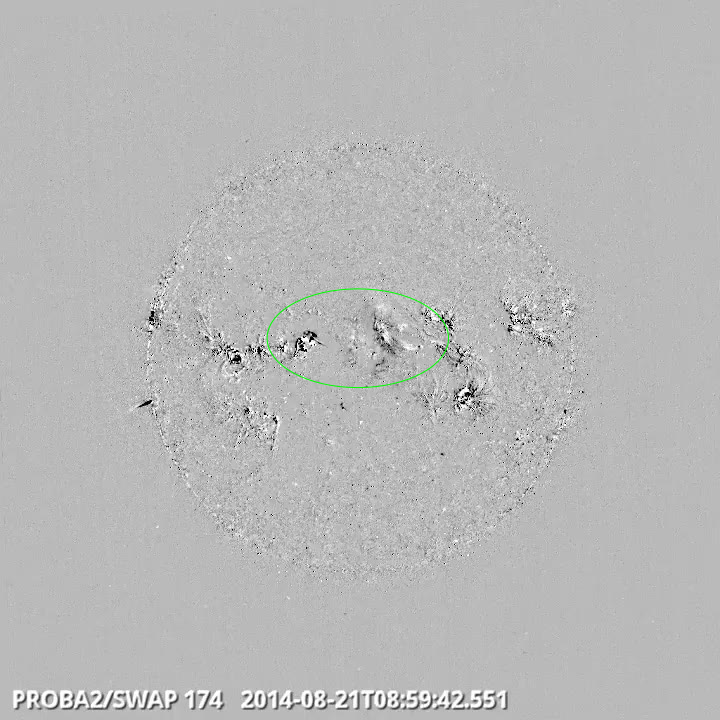
Eruption with EIT wave, solar centre, from AR 12146 @ 17:57 - SWAP difference image
A movie showing two of the EIT waves (on August 22) can be seen here: http://proba2.oma.be/swap/data/mpg/movies/WeeklyReportMovies/WR230_Aug18_Aug_24/20140822_2Eruptions_center_1022_SWAPdiff.mp4.
On Sunday, an M5.9 flare occurred on the East limb, from the newly emerging AR 12151 on the East limb. This eruption, and the mass expelled, is very impressive and could have been seen way beyond the SWAP FOV (see the image and movie below). Some of the expelled material falls back. Simultaneously, another EIT wave occurs at AR 12146.
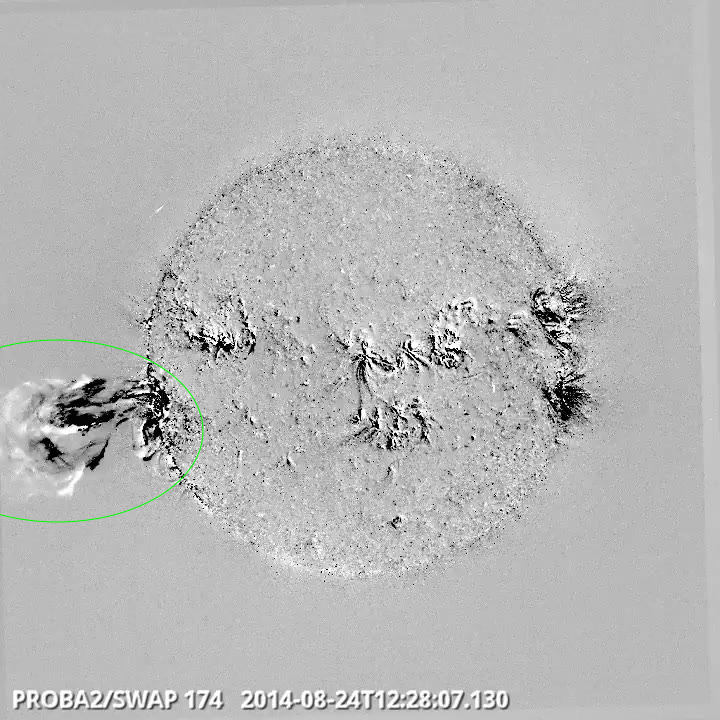
A movie showing the M5.9 flare eruption can be seen here: http://proba2.oma.be/swap/data/mpg/movies/WeeklyReportMovies/WR230_Aug18_Aug_24/20140824_M59Eruption_EastLimbPlus_1228_SWAPdiff.mp4.
Solar activity was low to moderate throughout the week with mostly C flaring and a total of 3 M flares. Two of those originated from NOAA AR 2149, an M3.4 flare peaking at 13:31 UT August 21 and an M1.2 flare peaking at 6:28 UT August 22. The third and biggest flare originated from the recent region NOAA AR 2151 on the East limb, peaking at 12:17UT August 24 at a magnitude of M5.9. Several outbursts, 11 in total originated from behind the East limb. The source region was not linked at that time with an active region. These are coloured green in the chart below. On August 22, NOAA AR 2149 turned over the East limb at that latitude.
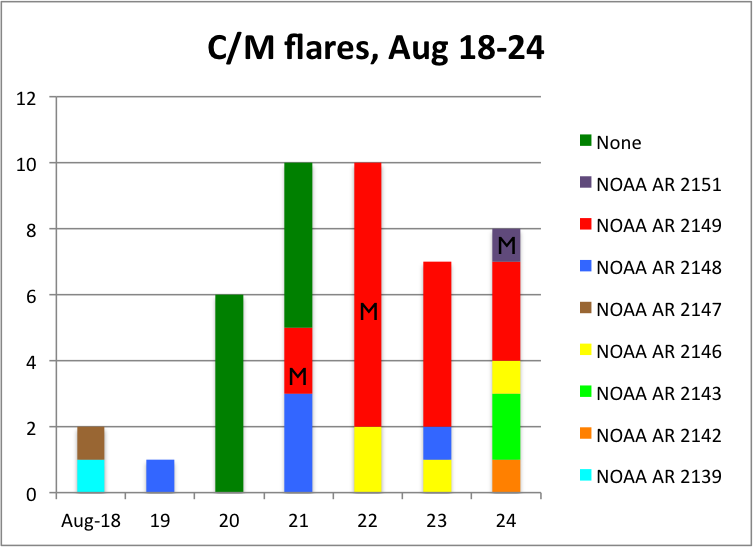
Solar wind conditions were marked by the arrival of the August 15 CME. The shock arrival (dotted line in the graph) was first visible in ACE data around 6:00UT August 19. During the CME passage, solar wind speed peaked at close to 470km/s in the afternoon of August 19. The interplanetary magnetic field reached a magnitude of 21.5nT in the morning of August 20. The Bz component was negative in the afternoon of August 19 with a peak of -15nT but turned fully positive during the remainder of the CME passage.
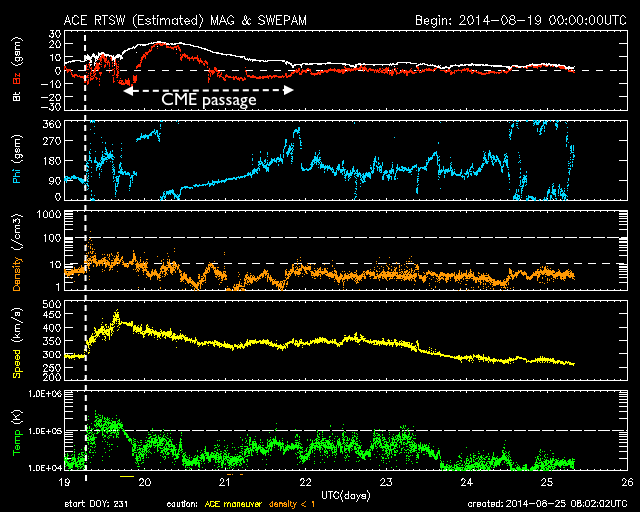
| DAY | BEGIN | MAX | END | LOC | XRAY | OP | 10CM | TYPE | Cat | NOAA |
| 21 | 1319 | 1331 | 1342 | N6E38 | M3.4 | SF | III/2VI/2 | 2149 | ||
| 22 | 0618 | 0628 | 0634 | N12E73 | M1.2 | 1F | 2149 | |||
| 24 | 1200 | 1217 | 1225 | M5.9 | B | 410 | II/1I/1 5 | 2151 |
| LOC: approximate heliographic location | TYPE: radio burst type |
| XRAY: X-ray flare class | Cat: Catania sunspot group number |
| OP: optical flare class | NOAA: NOAA active region number |
| 10CM: peak 10 cm radio flux |
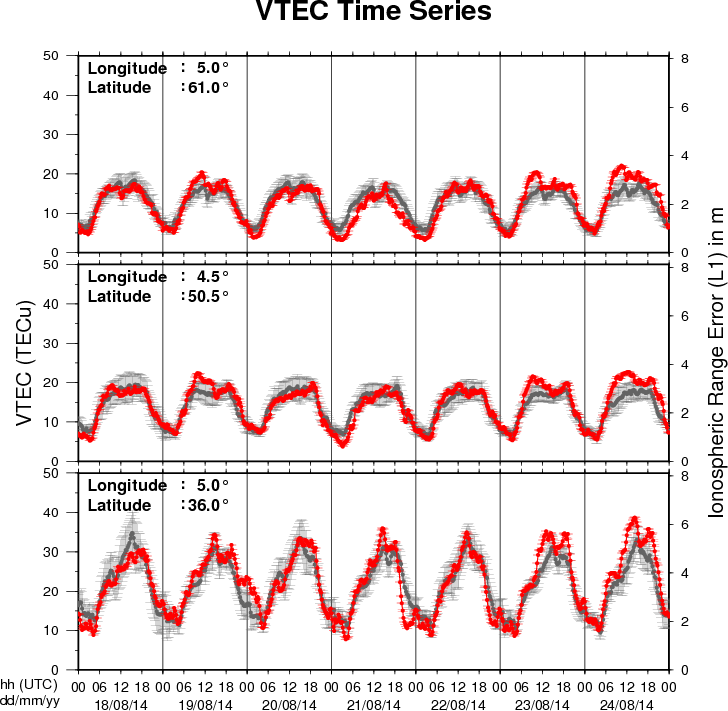
The figure shows the time evolution of the Vertical Total Electron Content (VTEC) (in red) during the last week at three locations:
a) in the northern part of Europe(N61°, 5°E)
b) above Brussels(N50.5°, 4.5°E)
c) in the southern part of Europe(N36°, 5°E)
This figure also shows (in grey) the normal ionospheric behaviour expected based on the median VTEC from the 15 previous days.
The VTEC is expressed in TECu (with TECu=10^16 electrons per square meter) and is directly related to the signal propagation delay due to the ionosphere (in figure: delay on GPS L1 frequency).
The Sun's radiation ionizes the Earth's upper atmosphere, the ionosphere, located from about 60km to 1000km above the Earth's surface.The ionization process in the ionosphere produces ions and free electrons. These electrons perturb the propagation of the GNSS (Global Navigation Satellite System) signals by inducing a so-called ionospheric delay.
See http://stce.be/newsletter/GNSS_final.pdf for some more explanations ; for detailed information, see http://gnss.be/ionosphere_tutorial.php
Start : 2014-09-07 - End : 2014-09-12
Planetary space weather can be characterised by changes in the
ambient planetary magnetic field and plasma populations around the
planetary environment while space climate refers to the long-term
changes in space weather conditions. Space weather and space
climate are driven by the changes in the Sun. The effects of Space
Weather on the Earth's environment are well documented,
particularly in terms of risk to satellites, communications and
ground-based systems such as electrical power grids and pipelines.
However, planetary space weather and space climate studies as well
as better prediction models for space weather are needed. Typically
differences in the magnetic field and plasma environment at
different planets, as well as the distance of the planet from the
sun drives different space weather effects as we move through the
solar system. The use of solar wind propagation models combined
with solar observations allows us to obtain and predict the
interplanetary conditions around each planet.
We solicit papers on planetary as well as terrestrial space
weather and space climate, where data from past and on-going space
missions such as ACE, SOHO, SDO, MEX, VEX, MESSENGER and CASSINI is
used. We welcome papers on observations as well as modeling of
space weather and space climate in our solar system.
Website:
http://meetingorganizer.copernicus.org/EPSC2014/session/16809
Start : 2014-09-09 - End : 2014-09-11
The Workshop on Radiation Monitoring for the International Space
Station (WRMISS) has been held annually since 1996. The major
purpose of WRMISS is to provide a forum for discussion of technical
issues concerning radiation dosimetry aboard the International
Space Station and other spacecraft. This includes discussion of new
results, improved instrumentation, detector calibration, and
radiation environment and transport models. The goal of WRMISS is
to enhance international efforts to provide the best information on
the space radiation environment in low-Earth orbit and on the
exposure of astronauts and cosmonauts in order to optimize the
radiation safety of space crew.
Website:
http://www.ifj.edu.pl/conf/wrmiss/
Start : 2014-09-15 - End : 2014-09-20
The 'Geospace Revisited' conference aims at revisiting
long-standing issues of geospace dynamic phenomena. New data from
space missions like Cluster, THEMIS and the more recent Van Allen
Probes, along with measurements from ground-based magnetometer
arrays around the globe, processed with new methods and combined
with theory and simulations are expected to shed light on the
complex interplay of particles, fields and waves in geospace, and
in particular the inner magnetosphere (radiation belts and ring
current).
Website:
http://geospacerev.space.noa.gr/index.php
Start : 2014-11-12
This conference aims to bring together researchers, engineers,
users in the area of Big Data in the Space sector.
The focus is on the whole data lifecycle, ranging from data
acquisition by spaceborne and ground-based sensors to data
management, analysis and exploitation in the domains of Earth
Observation, Space Science, Space Engineering, Space Weather,
etc.
Special emphasis will be put on highlighting synergies and
cross-fertilization opportunities from domains like Climate Change,
Solid Earth Science, Planetary Sciences, Life Science,
Astrophysics, High Energy Physics, Social Sciences, etc.
We expect this conference to:
* contribute towards a common "Big Data from Space" scientific
and programmatic framework
* widen competences and expertise of universities, labs and
industrial actors
* foster networking of experts and users towards better access
and sharing of data, tools and resources
* leverage innovation, spin-in, spin off of technologies, and
business development arising from research and industry
progress
Website:
http://congrexprojects.com/2014-events/BigDatafromSpace/objectives
Start : 2014-11-17 - End : 2014-11-21
The 11th Edition of the European Space Weather Week will take
place on 17-21nd November 2014 in Liège, Belgium.
The ESWW will again adopt the central aim of bringing together
the diverse groups in Europe working on different aspects of Space
Weather. This includes but isn't limited to the scientific
community, the engineering community, applications developers,
service providers and service end users.
The meeting organisation is coordinated by the Belgian
Solar-Terrestrial Centre of Excellence (STCE), ESA and the Space
Weather Working Team. The local organisation is done by the
STCE.
Website:
http://www.stce.be/esww11/
Start : 2014-12-15 - End : 2014-12-19
The AGU Fall Meeting is the largest worldwide conference in the
geophysical sciences, attracting more than 22,000 Earth and space
scientists, educators, students, and other leaders. For 46 years,
energized and passionate Earth and space scientists from around the
world gather at the AGU Fall Meeting to connect with colleagues,
broaden their knowledge base, and embrace the joy of science. The
2014 meeting takes place Monday 15 - Friday 19 December 2014.
Several sessions about space weather are foreseen:
*
When and Why Does Space weather Forecasting Fail?
*
Addressing Operational Space Weather Needs
*
Near Real Time Data for Earth Science and Space Weather
Applications
*
Understanding Hemispheric Asymmetry and Space Weather
*
Connection of Solar Events With the Variability of Space
Environments
*
Bz from the Sun to the Earth: Observations and Modeling
*
Solar Sources and Heliospheric Consequences of Coronal Mass
Ejections in Solar Cycle 24
*
Advances in Ionospheric Forecasting - Modeling, Observations, and
Validation
Abstract Submission Deadline: August 6, 2014
Website:
http://fallmeeting.agu.org/2014/
Start : 2015-04-20 - End : 2015-04-24
This gathering was born out of the desire to collect in one
place the latest technologies required for advancement of science
in the discipline of Solar and Space Physics. In doing so, it was
recognized that the two 1998 volumes of 'Measurement Techniques in
Space Plasmas' (Particles and Fields) have been a valuable
reference and resource for advanced students and scientists who
wish to know the fundamentals of measurement techniques and
technology.
Website:
https://mtssp.msfc.nasa.gov/
Start : 2015-06-22 - End : 2015-07-02
We invite contributions on novel inversion methods with
application across the geosciences. Of particular interest are 3D
imaging, joint inversion of geodetic, geophysical and geochemical
datasets, and multi-disciplinary interpretation approaches such as
integration of gravity, EM and seismic data or thermo-mechanical
modelling studies constrained by physical parameters.
Modelling of Space Weather Effects: Solar, Magnetospheric and
Earth Resistivity Constraints (IAGA, IAMAS)
In this symposium we welcome contributions on all aspects of the
modelling of space weather and its effects, from the Sun to Earth.
This includes the modelling of the various interactions between
travelling solar storms and the solar wind, magnetosphere,
ionosphere and solid Earth and the validation of models through
measurements. Contributions on models developed to aid end-users,
such as satellite and power grid operators, survive the impact of
space weather are also encouraged.
Website:
http://www.iugg2015prague.com/joint-inter-association-symposia.htm#JA